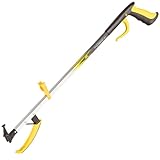Key Takeaways For Best Mobility Aids
Benefits of Mobility Aids: Discover enhanced mobility, increased independence, and improved quality of life with various aids, ranging from bathroom grab rails to rollators and safety step stools.
Key Features to Consider: Evaluate factors like the type of aid, size, weight, adjustability, and comfort when selecting a mobility aid. Terrain compatibility, battery life (for electric aids), and durability are crucial considerations.
Top Picks in the Market: Explore a range of best-selling mobility aids, including suction bathroom grab rails, lightweight rollators, safety step stools, and more, each designed to address specific mobility needs effectively.
Top Mobility Aids
Welcome to our Best Mobility Aids Guide! Explore top-notch solutions designed to enhance daily living. From walkers to canes, this guide highlights the most effective mobility aids available. Discover key features, user reviews, and expert recommendations to help you make informed choices tailored to your needs. Streamline your search for reliable support and improved mobility with this concise overview of the best mobility aids on the market.
Mobility aids are essential tools that assist individuals with mobility limitations maintain their independence and improve their quality of life. These aids come in various forms, from walking to wheelchairs and scooters. In this article, we will explore the benefits of mobility aids, the key features to consider when selecting one, and some of the top picks in the market.
Benefits of Mobility Aids:
- Enhanced Mobility: Mobility aids allow individuals with limited mobility to move freely and independently. They provide support and stability, enabling individuals to navigate their surroundings with confidence and ease.
- Increased Independence: With mobility aids, individuals can perform daily activities, run errands, and engage in social interactions without relying on others for assistance. This promotes a sense of independence and self-reliance.
- Improved Quality of Life: Mobility aids improve quality of life by reducing physical barriers and limitations. They allow individuals to participate in enjoyable activities, maintain social connections, and explore their environments.
Key Features to Consider:
- Type of Mobility Aid: Determine the type of mobility aid that best suits your needs. Options include walking aids, wheelchairs (manual or electric), mobility scooters, and rollators. Consider your mobility level, intended use, and terrain compatibility when selecting the most suitable mobility aid.
- Size and Weight: Consider the size and weight of the mobility aid, particularly if you plan to transport or store it frequently. Lightweight and compact designs are beneficial for ease of manoeuvrability and portability.
- Weight Capacity: Ensure that the mobility aid comfortably supports your body weight or any additional load. Check the weight capacity specifications to ensure it meets your requirements.
- Adjustability and Comfort: Look for mobility aids that offer adjustable features to accommodate individual needs. Features such as height-adjustable handles, seat height adjustments, and padded support provide customisation for comfort and proper body alignment.
Best Selling Mobility Aids
Additional Considerations:
- Terrain Compatibility: Consider the environments where you plan to use the mobility aid. Some aids are designed for indoor use, while others are suitable for indoor and outdoor terrains. Choose a mobility aid that matches your intended usage and provides the necessary features for the surfaces you will encounter.
- Battery Life and Range: If you are considering electric mobility aids such as wheelchairs or scooters, evaluate the battery life and range. Longer battery life and extended range allow for extended use without frequent recharging.
- Durability and Maintenance: Assess the mobility aid’s durability and maintenance requirements. Look for high-quality construction and easy-to-maintain features that ensure longevity and minimise the need for repairs or replacements.
Dos and Don’ts for Choosing the Best Mobility Aids
Dos:
- Consult Healthcare Professionals: Seek advice from healthcare professionals, such as doctors or physical therapists, to determine the most suitable mobility aids based on your needs and conditions.
- Consider Individual Requirements: Evaluate your specific mobility requirements, taking into account factors such as stability, balance, and the nature of daily activities.
- Test Before Purchase: Whenever possible, test different mobility aids to assess comfort, ease of use, and overall functionality before purchasing.
- Prioritise Safety Features: Look for mobility aids with enhanced safety features, such as sturdy construction, non-slip surfaces, and ergonomic design, to minimise the risk of accidents.
- Think About Storage and Portability: Consider the storage space available and the mobility aid’s portability. Choose aids that can be easily transported or stored when not in use.
- Research User Reviews: Read user reviews and testimonials to gather insights into the real-world experiences of individuals who have used the particular mobility aids you are considering.
Don’ts:
- Ignore Professional Guidance: Consult a healthcare professional before making decisions. Their expertise can guide you toward the most appropriate mobility aids for your health conditions.
- Select Without Testing: Only choose a mobility aid with testing its suitability. Testing helps ensure that the aid meets your comfort and functionality requirements.
- Overlook Maintenance Requirements: Neglecting the maintenance needs of mobility aids can impact their longevity and performance. Follow manufacturer guidelines for proper upkeep.
- Prioritise Appearance Over Functionality: While aesthetics matter, don’t prioritise appearance over functionality. Choose mobility aids that best address your mobility challenges and needs.
- Neglect Adjustment Options: Ensure that the chosen mobility aids have adjustable features to accommodate changes in your physical condition or to suit different users if necessary.
- Disregard User Feedback: Pay attention to user feedback and reviews. Insights from others using the same mobility aids can provide valuable information about their effectiveness and durability.
When selecting the best mobility aids, considering individual needs and seeking professional advice, a thoughtful and informed approach ensures that the chosen aids contribute positively to daily life and overall well-being.
Summary of Mobility Aids:
Mobility aids offer numerous benefits, including enhanced mobility, increased independence, and improved quality of life. When choosing a mobility aid, consider factors such as the type of aid, size and weight, weight capacity, adjustability and comfort features, terrain compatibility, battery life and range (for electric aids), durability, and maintenance requirements. By carefully evaluating these factors and exploring the top picks in the market, you can find a mobility aid that suits your specific needs, promoting greater mobility and independence in your daily life.
Frequently Asked Questions About The Best Mobility Aids:
What are mobility aids?
Mobility aids are devices or equipment designed to assist individuals with mobility limitations in performing daily activities and maintaining independence. They provide support, stability, and improved mobility for individuals with various mobility challenges.
What types of mobility aids are available?
There are various types of mobility aids available to suit different needs. Some common types include:
- Canes: Canes provide support and balance assistance for individuals who need minimal aid while walking.
- Walkers: Walkers offer stability and support for individuals who require more assistance and balance support. They come in different designs, including standard walkers, wheeled walkers, and rollators.
- Wheelchairs: Wheelchairs are mobility aids for individuals with more significant mobility limitations. They come in manual or electric models designed for self-propulsion and assisted mobility.
- Mobility scooters: Mobility scooters are battery-powered devices that provide transportation for individuals who have difficulty walking longer distances or need assistance outdoors.
- Crutches: Crutches are walking aids that provide support under the arms to assist individuals with balance and mobility while keeping weight off an injured leg or foot.
- Transfer aids: Transfer aids, such as transfer boards or poles, assist individuals in transferring from one surface to another, such as from a bed to a wheelchair or from a wheelchair to a car.
What factors should I consider when choosing a mobility aid?
When choosing a mobility aid, consider the following factors:
- Type of mobility aid: Determine the type that most suits your needs and limitations.
- Comfort and fit: Ensure that the mobility aid provides a comfortable fit and is appropriate for your height, weight, and body proportions. Consider features such as adjustable handles, seats, or leg rests.
- Safety features: Look for mobility aids with non-slip grips, brakes, reflectors, or lights for enhanced safety during use.
- Portability and storage: If portability is important, consider the mobility aid’s weight, foldability, or disassembling options for transportation and storage.
- Durability and quality: Assess the mobility aid’s durability and quality to ensure it can withstand regular use and provide long-term reliability.
- User-friendly features: Consider features that make the mobility aid easier to use, such as intuitive controls, adjustable settings, or ergonomic designs.
- Warranty and customer support: Review the manufacturer’s warranty and consider the availability of customer support in case of any issues or questions.
Where can I purchase mobility aids?
Mobility aids can be purchased from medical supply stores, equipment providers, online retailers, and pharmacies. Try different models and consult healthcare professionals or physical therapists to determine the most suitable mobility aid.
When choosing a mobility aid, consider your mobility requirements, comfort, safety, and usability. Seek professional advice and prioritise quality and reliability to ensure the best mobility aid.
Top Mobility Aids
Explore More Mobility Aids for Enhanced Independence
- Best Walking Aids – Discover walking aids designed to provide stability and support.
- Best Crutches – Find top-rated crutches for added mobility and comfort.
- Best Mobility Scooters – Explore mobility scooters that offer comfort and independence.
- Best Rollators – Learn about rollators designed for stability and safety while walking.












